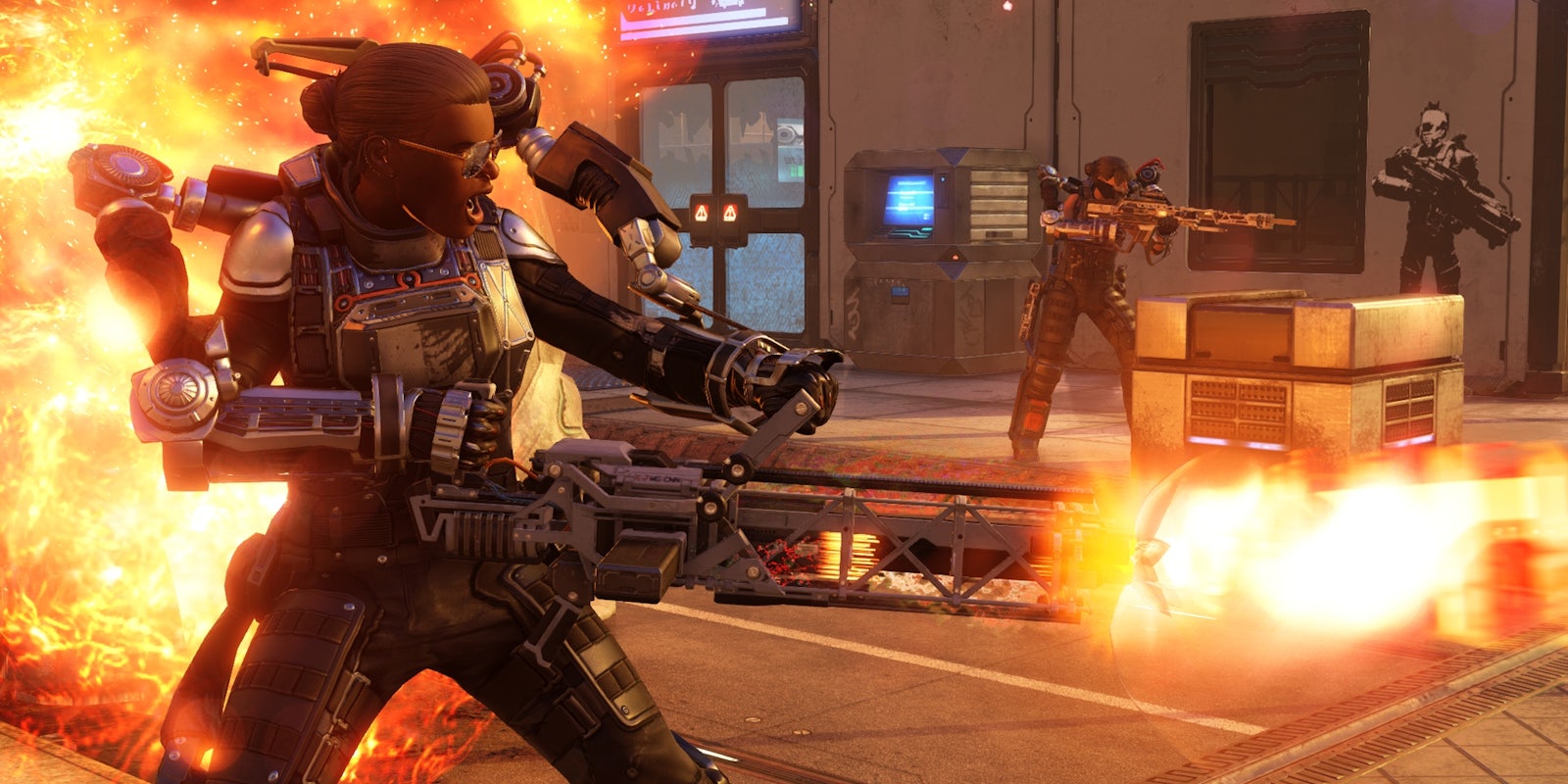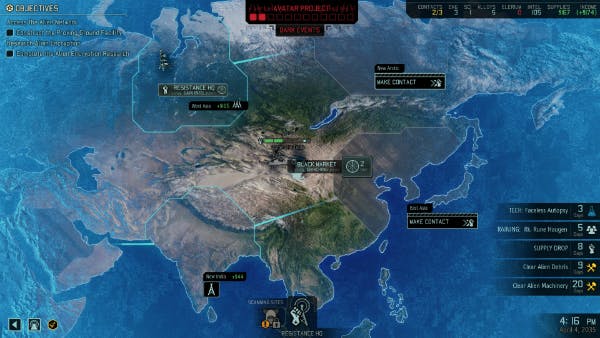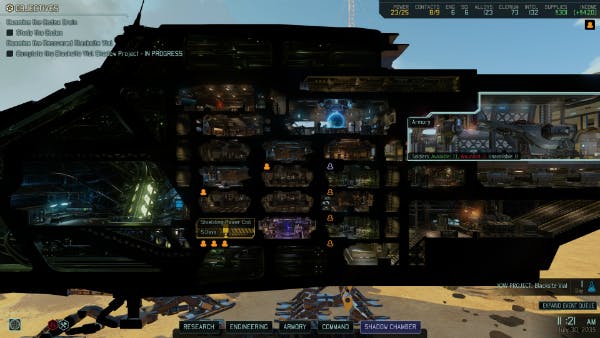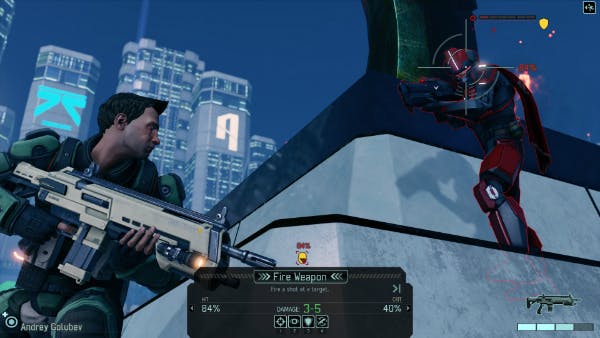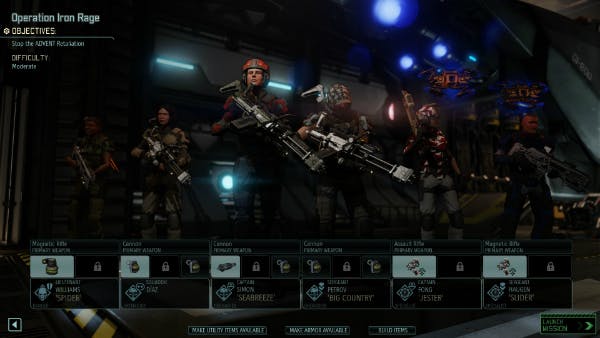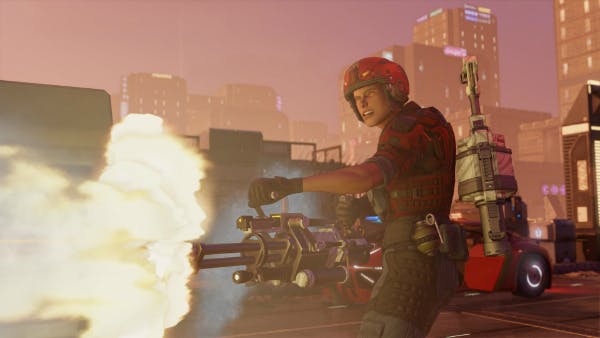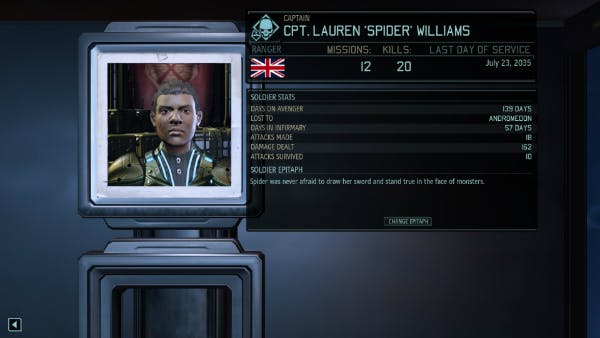Cpt. Lauren Williams died screaming as her body dissolved in weaponized acid. This isn’t the way I wanted her comrades to remember her, as I wrote Williams’s epitaph.
Turn-based strategy games are usually intellectual exercises where your soldiers are nameless and faceless, just one of hundreds or thousands of troops represented by a unit icon on a map.
In 2012’s XCOM: Enemy Unknown, however, you commanded between four and six soldiers in battles that were up close and personal. These men and women of the XCOM project defended Earth against a horde of invading alien species.
Soldiers began as disposable rookies with few skills. As they won battles they grew into veterans with powerful abilities, and losing a veteran trooper toward the end of the game could be devastating. Their rookie replacements couldn’t handle powerful end-game enemies.
No one could have predicted the degree to which players of XCOM: Enemy Unknown would bond with their soldiers, taking advantage of a limited suite of customization options, most importantly names and nicknames, to make their soldiers their own. The awfulness of losing a veteran soldier might not only be the frustration of losing a powerful playing piece. It could also feel like losing a character in a role-playing game.
XCOM 2 doubles-down on the difficulty of the tactical and strategic halves of the game, and the increased risk may help players form even stronger relationships with their soldiers than in Enemy Unknown. I took the time to write an epitaph for Cpt. Williams that no one but me would ever read—that’s when I knew just how good this game is.
XCOM 2 assumes that the player failed to defend the Earth in Enemy Unknown. A human government called ADVENT has collaborated with the alien occupiers for 20 years. Citizens have been herded into high-tech city centers with the promise of gene therapy that can cure any ailment, but people are vanishing from the cities in huge numbers.
The remnants of the XCOM force, humanity’s only line of defense against the original invasion, have cobbled together a mobile headquarters called the Avenger. You are placed in command of the rejuvenated XCOM, with the goal of unifying the global resistance network, to stop an alien project code-named Avatar.
At the top of the strategic map where you move the Avenger between different regions and choose targets for missions is a tracker for the aliens’ completion of the Avatar project. You can set the project back temporarily by destroying Blacksite bases, which are extremely difficult missions to complete.
To get to the Blacksite bases you have to make contact with the resistance cell in the region where the base is located. You make contact with resistance cells by expending a resource called Intel. You can earn Intel in monthly supply drops, by parking the Avenger at resistance headquarters and activating the Avenger’s scan function, as a mission reward, and by seizing and decrypting alien data caches.
Intel is generally more difficult to come by than Supplies, which are regularly provided by the resistance in supply drops on the strategic map. You are given ample opportunities to raid enemy supply convoys, and the more resistance cells you’ve made contact with the larger your monthly income of Supplies.
You also spend your Supplies on a much wider array of things. The Scientists and Engineers that research new technology and expand the capabilities of the Avenger require Supplies for their projects, and the better the technology behind your weapons, armor, and gadgets, the more Supplies they cost to produce.
In addition to their steady progress toward completing the Avatar project, the aliens are also always working on smaller projects called Dark Events. Completed Dark Events give the aliens unique advantages that last for one month.
Your Intel costs can be increased, and your supply amounts decreased. Dark Event projects can give alien soldiers better weapons and armor, or guarantee the arrival of reinforcements in every mission you undertake.
Guerrilla Ops are your opportunity to counter these Dark Events, but you can only choose one out of three Ops to undertake, each of which counters a specific, upcoming Dark Event. You can only see all three available Ops, rather than the two default options, by spending Intel.
The aliens are always counting down to their next Retaliatory Strike, in which they attack a resistance base and slaughter civilians. It’s not enough to just kill the strike force in these missions. You also have to rescue a specified number of civilians. If you fail enough of these Retaliatory Strike missions, the resistance cells in those regions will go dark.
Other missions require the rescue or elimination of VIPs, protecting resistance equipment or destroying ADVENT gear, and the aforementioned supply convoy raids. Most missions provide rewards of Intel, Supplies, Engineers, and Scientists. You can also sell recovered alien bodies and technology for Supplies at a Black Market, and spend Intel there to buy weapons upgrades and to rush research projects.
The Avatar project tracker becomes oppressive in the latter stages of XCOM 2. You may find yourself desperately launching Blacksite strikes, with only days to spare before the project is completed, scrambling to earn enough Intel to unlock the regions where the Blacksite bases are located, and scraping together the Supplies you need to build the weapons and armor without which your soldiers will not survive.
Firaxis has done a wonderful job of taking the life-and-death, intense pressure of the tactical infantry game, and mapping it onto the strategic game.
The basic mechanics of the tactical, turn-based infantry combat in XCOM 2 work the same way as in Enemy Unknown. You move all of your units, then the aliens move theirs. Smart use of cover and flanking the enemy are the basic skills you need to complete missions.
All the cover in XCOM 2 is destructible, which is a major evolution from Enemy Unknown. Urban combat in the city centers is nasty in late-game fights when both sides have access to explosives with a very wide detonation radius. One second you can have a soldier in perfect cover at the corner of a building and with a single explosion find your soldier standing right out in the open because the building isn’t there anymore.
There is a deeper roster of alien types in XCOM 2 than in Enemy Unknown. Shape-shifters hide as regular civilians at the beginning of a fight, then transform into hulking melee units with zero warning. Mechanized units can destroy huge chunks of the map with devastating energy barrages, forcing your entire squad to rapidly reposition.
There are several varieties of fast-moving melee units that have to immediately be prioritized as targets when they appear, and aliens with Psionic abilities can mind control your troops. These aliens ought to become your number one concern if you can afford to re-task soldiers for the job.
There’s little room for tactical error in XCOM 2. In fact, my chief complaint about the game is that it felt far too punishing in the early missions before my soldiers had decent weapons or armor or had attained even basic combat abilities. Losing a bunch of soldiers early on was disheartening to the point where I changed the game to Easy just so I could promote a decent stable of Rookies into the four soldier classes.
Soldiers in XCOM 2 feel more fluid in their roles, versus soldiers in Enemy Unknown. Rangers are still focused on rapid movement and attack like their Assault-class predecessors, but Rangers also have stealth and evasion abilities and powerful sword-based melee attacks.
Specialists in XCOM 2 rely less on consumables to provide defensive benefits like Support-class characters did in Enemy Unknown. Specialists also command Gremlin drones that can deliver heals to soldiers across the map, or project force-fields around soldiers while the Specialist takes offensive action.
Sharpshooters in XCOM 2 are still defined by long-range combat abilities, like Sniper-class characters were in Enemy Unknown, but Sharpshooters have much better pistol skills that allow them to more readily function as regular infantry, rather than having to sit still and shoot all the time. Grenadiers in XCOM 2 are very similar to Heavy-class characters in Enemy Unknown, and they feel the least evolved of all the new soldier types.
This relative fluidity of roles helped mitigate the increased difficulty of XCOM 2, but the real game-changer is that your squad often begins a mission in stealth and is able to maneuver freely, with map spaces marked if they are within enemy lines of sight. Discovery by the aliens breaks stealth for everyone in your squad except Rangers with stealth talents.
A new ability called Concealed Overwatch, which is only available while your squad is in stealth, allows you to spring ambushes. There were few things more satisfying in XCOM 2 as successfully executing an ambush, watching every member of my squad go loud simultaneously and slaughter entire enemy units of multiple soldiers before they even had a chance to respond.
The other major evolution introduced by XCOM 2 is the number of soldier customization options. In addition to giving soldiers custom names and nicknames, you may also choose their country of origin. Instead of every soldier speaking English by default, you can choose between multiple voices in American English, U.K. English, Australian English, Spanish, German, French, and Italian.
My second remaining complaint about XCOM 2 is the lack of any non-European languages. What voice do you give to Russian, Ukrainian, Chinese, or Japanese soldiers?
Face props like cigars and piercings, camo patterns and color options for weapons and armor, giving soldiers new facial scars to represent their wounds and tattoos to celebrate their victories are all fun ways to customize your soldiers.
Rather than losing all this work when and if your soldiers are killed, you can save them to your Character Pool. Characters in the pool will show up as recruits in your future games of XCOM 2. You will be able to import other players’ characters pools and share your character pool with the XCOM 2 community.
You can even create soldiers off the main menu, rather than having to first jump into the game, and then save those characters to the pool. I had a dozen soldiers designed before I even played my first mission.
It hurts to lose soldiers, especially when you make a mistake and realize you’ve allowed someone to be outflanked. You’ll see the death coming. You may hope out loud that every shot will miss your vulnerable trooper. Achieving the mission salves the loss. You’ll keeping playing XCOM 2 because your other soldiers still need you, and because the only thing that justifies their sacrifices is victory.
Cpt. Williams, known as “Spider” to her comrades, died during a raid on a supply convoy. I made a grievous tactical error by grouping too many soldiers together, in the process creating an irresistible target for an alien weapon that bathed the area in acid.
Three soldiers managed to survive the attack, retreat, and be healed by the Specialists’ Gremlin drones, but Williams’s health had been low even before the acid attack. The subsequent burns killed her.
As a result of my miscalculation, with Spider off the line, the remaining members of the squad had to in desperation use explosives to clean up the remainder of the alien guard unit. It was an unrewarding victory. The explosives tragically destroyed a portion of the supplies that Cpt. Williams had died to recover.
Her portrait now hangs on the memorial wall of the Avenger. She partook in 12 missions and served in XCOM for 139 days. She was wounded in battle 10 times and had 20 kills. Written on the plaque that bears her photo is a simple epitaph.
“Spider was never afraid to draw her sword and stand true in the face of monsters.”
Disclosure: Our Steam review copy of XCOM 2 was provided courtesy of 2K Games.
Illustration via 2K Games

